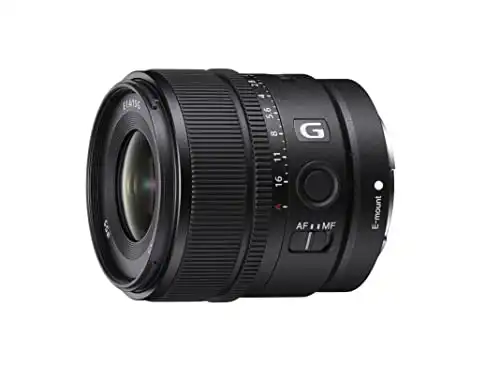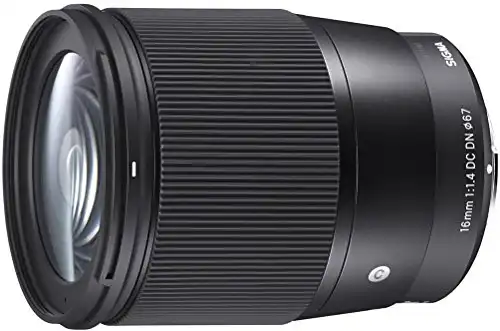Wide-angle prime lenses are useful lenses that can capture a wide field of view and create a sense of depth and perspective in your images. They are ideal for landscapes, architecture, interiors, street photography, and environmental portraits. They can also perform well in low-light situations, thanks to their fast apertures.
In this article, we will compare Sony E 15mm F1.4 G vs Sigma 16mm F1.4 DC DN Contemporary in detail and help you decide which one is better for you.
Two of the most popular wide-angle prime lenses for Sony E mount cameras are the Sony E 15mm F1.4 G and the Sigma 16mm F1.4 DC DN Contemporary. Both lenses offer a bright F1.4 aperture, a high-quality build and performance, and a reasonable price.
But how do they compare in terms of features, specifications, image quality, and size? Which one should you buy for your wide-angle needs?
Table of Contents
ToggleFeatures and Specifications
The table below summarizes the main features and specifications of the Sony E 15mm F1.4 G vs Sigma 16mm F1.4 DC DN Contemporary.
| Feature | Sony E 15mm F1.4 G | Sigma 16mm F1.4 DC DN Contemporary |
| Mount | Sony E | Sony E |
| Full Frame | No | No |
| Autofocus | Yes | Yes |
| Image Stabilization | No | No |
| Lens Construction | 13 elements in 12 groups (3 aspherical, 1 ED, 1 Super ED) | 16 elements in 13 groups (3 aspherical, 3 FLD, 2 SLD) |
| Angle of View | 87° (full frame), 60° (APS-C) | 83.2° (full frame), 56.6° (APS-C) |
| Diaphragm Blades | 9 (rounded) | 9 (rounded) |
| Minimum Aperture | f/22 | f/16 |
| Minimum Focusing Distance | 0.17m (MF), 0.2m (AF) | 0.25m |
| Maximum Magnification Ratio | Wide: 0.15x (MF), Tele: 0.12x (AF) | Wide: 0.07x |
| Filter Size | 55mm | 67mm |
| Dimensions | Φ67 x L70mm (E-mount) | Φ72.2 x L92.3mm (E-mount) |
| Weight | E-mount: 219g; L-mount: 224g | E-mount: 405g; L-mount: 410g |
As you can see from the table, the two lenses have similar features and specifications, with some minor differences. Neither lens has image stabilization, so you will need to rely on your camera’s in-body image stabilization (IBIS) or use a tripod for sharper images.
The main difference between the two lenses is the focal length. The Sony lens has a slightly shorter focal length of 15mm, which can give you a slightly wider angle of view and a slightly shorter working distance (the distance between the front of the lens and the subject at the minimum focus distance).
This can be useful for capturing more of the scene or getting closer to the subject and filling the frame with more details.
The Sigma lens has a slightly longer focal length of 16mm, which can give you a slightly narrower angle of view and a slightly longer working distance. This can be useful for avoiding distortion or perspective issues when shooting close-up subjects or portraits.
The Sony lens also has fewer lens elements than the Sigma lens (13 vs 16), which can affect the optical performance and quality of the lens. The Sony lens also has a smaller filter size than the Sigma lens (55mm vs 67mm), which can make it easier to find and use filters.
The Sigma 16mm F1.4 lens is much cheaper than the Sony lens, which can be a significant factor for beginners or hobbyists who have a limited budget. The Sigma lens is also much larger and heavier than the Sony lens (405g vs 219g for E-mount), which can make it less portable and comfortable to carry around or use for long periods of time.
Sigma 16mm F1.4 DC DN Contemporary
Image Quality: Sony E 15mm F1.4 G vs Sigma 16mm F1.4 DC DN Contemporary
Both lenses deliver excellent image quality in terms of sharpness, contrast, color rendition, distortion, vignetting, flare, and bokeh. They are both very sharp across the frame, even at wide open apertures. They also have minimal chromatic aberrations and field curvature. They also handle diffraction well up to f/16.
The bokeh quality of both lenses is smooth and pleasing, thanks to their bright F1.4 aperture and rounded diaphragm blades. The out-of-focus areas are rendered softly and naturally, especially at close distances and wide apertures.
The distortion and vignetting of both lenses are very low and can be easily corrected in post-processing or by applying lens profiles. The flare resistance of both lenses is also very good, thanks to their anti-reflective coatings and lens hoods.
The main difference between the two lenses in terms of image quality is the focal length. The Sony lens has a slightly shorter focal length of 15mm, which can give you a slightly wider angle of view and a slightly shorter working distance.
This can be useful for capturing more of the scene or getting closer to the subject and filling the frame with more details. The Sony lens can also create a slightly wider perspective and a slightly shallower depth of field for creating a sense of depth and dimension in your images.
The Sigma 16mm F1.4 lens has a slightly longer focal length of 16mm, which can give you a slightly narrower angle of view and a slightly longer working distance. This can be useful for avoiding distortion or perspective issues when shooting close-up subjects or portraits.
The Sigma lens can also create a slightly more flattering perspective and compression effect for portrait photography, as well as a slightly deeper depth of field for keeping more of the scene or subject in focus.
Best For: Photographers looking for a versatile lens with excellent low-light performance and reliable autofocus for capturing sharp images in various conditions.
- Exceptional low-light performance with a large f/1.4 aperture
- Lightweight and compact design for portability
- Reliable autofocus for fast-moving subjects
- Mixed opinions on bokeh and chromatic aberration
Conclusion
The Sony E 15mm F1.4 G and the Sigma 16mm F1.4 DC DN Contemporary are both excellent wide-angle prime lenses that can capture a wide field of view and create a sense of depth and perspective in your images. They both offer a bright F1.4 aperture, a high-quality build and performance, and a reasonable price.
The Sony lens has some advantages over the Sigma lens, such as a slightly shorter focal length, fewer lens elements, smaller filter size, and an aperture control ring with selectable click stops. However, it is also more expensive, smaller, and lighter than the Sigma lens.
The Sigma lens has some advantages over the Sony lens, such as a slightly longer focal length, more lens elements, lower price, and a fluorine coating on the front element to repel water and oil. However, it does not have a slightly shorter focal length, fewer lens elements, smaller filter size, or an aperture control ring with selectable click stops.
The choice between the two lenses depends on your personal preferences, needs, and budget. If you want a more wide-angle lens that can capture more of the scene or get closer to the subject, especially if you need more details or depth effects, you may prefer the Sony lens.
If you want a more standard-angle lens that can avoid distortion or perspective issues when shooting close-up subjects or portraits, especially if you need more flattering or focus effects, you may prefer the Sigma lens.
Both lenses are highly recommended for wide-angle enthusiasts who use Sony E mount cameras. You can’t go wrong with either of them.




